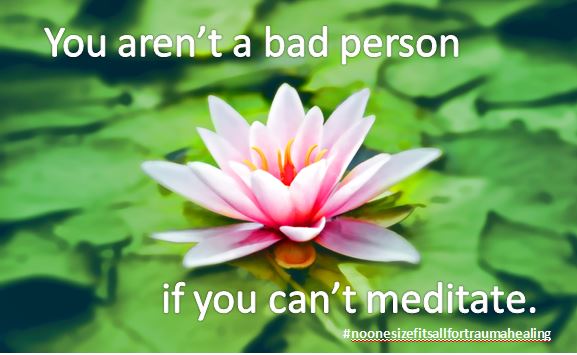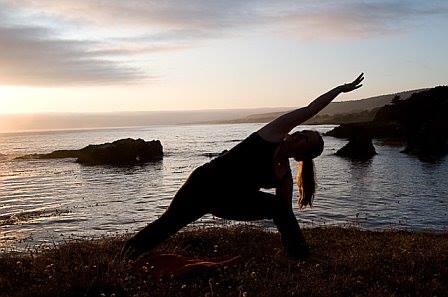In this age of information, there are some great resources for healing trauma that I follow online. People on these sites ask sincere questions and get sincere responses from fellow seekers based in what has worked for them.
Here’s an example:
“I’ve got so much tension in my body and now I’m understanding that it’s connected to my nervous system and old trauma. What kind of practice can I learn at home to release this tension? It’s really painful and never lets up.”
Answers come in with glowing reviews of many methodologies: yoga, meditation, mindfulness, Rolfing, Feldenkrais, Craniocacral therapy, breath work, TRE – on and on.
I sometimes find myself cringing because I want to tell people – approach with caution!
All of the methods people use have something to offer…with two big caveats:

I’m being ironic here, but people with trauma can feel like “here’s another thing I’ve failed at”. There is no one size fits all method for trauma.
- Just because it works for someone else (or everyone else for that matter), doesn’t mean it should work for you. And if it doesn’t work, it doesn’t mean you’re wrong.
- A method might be able to work for you if you have a strong brake pedal available in case the energy inside escalates, and if you can find a modification that doesn’t feel too challenging until your system can slowly accommodate the work. If you missed the last blog on this topic, you can find it here.
Several years ago, I decided to try craniosacral therapy. My intention for going was for tension in my neck and upper back. In my first session I was impressed to find Stephen Porges’ book, The Polyvagal Theory on my practitioner’s shelf. I thought she might be more versed in trauma physiology than I expected. It wasn’t the case. She was an excellent, well trained craniosacral practitioner, but her work was too stimulating for my nervous system. After each session I had what I called my “cranio hang over”, which felt like my sensitivity was amplified, a little head achy and very tired. I tried titrating by shortening the session length and asking her to pause when I felt stimulation increasing past a comfortable threshold, but ultimately I stopped going because though my spine felt better, the cranio hang overs were more than I wanted to deal with.
A couple years later I found the regulation work that Kathy Kain and Stephen Terrell co-teach and learned how to incorporate touch with clients to support the nervous system without over stimulating. I believe that when there is enough regulation in our nervous system, there is enough stability to handle practices that might otherwise be too much for the system.
In my craniosacral experience I was able to guide my practitioner and make clear requests about what I was needing. That’s not always possible for people with developmental trauma. If you’re not able to guide a practitioner for whatever reason, you may need to find a different method or seek a person with Somatic Experiencing training.
Here’s some advice from someone who’s been around the block with many, many practices (that’s me):
Common challenging responses with different forms of work:
My intention here is to give you some awareness of some things to pay attention to. You may not have any trouble with any of these practices. You may love them and find instant relief – if so great!
Mindfulness, meditation:
Bringing awareness inside can bring attention to the trauma physiology and amplify it. Responses can range from restlessness to fear to panic.For some people, sitting quietly in stillness brings their system into a dorsal state, which is often their system’s pattern – in other words, it reinforces a dissociative pattern.
Instead try: Focus attention outside your body to the environment. Never force your eyes, but just relax them and let them receive what you see. Let them go where they go. Approach observing your thoughts slowly, eg 1-2 minutes vs. longer sessions. Use exercises that give your mind something to pay attention to, like a grape in your mouth, the flame of a candle, etc. If you know you are prone to dissociation, try a more active/engaged practice (even a moving meditation) rather than something like Vipassana that is less structured.
Bodywork:
I put bodywork in two categories: First, what my teacher calls “furniture moving” bodywork, where there is manipulation of tissues with pressure/force, like massage, Rolfing, Thai massage, etc. Second is the more still variations like Craniosacral, Reiki or Osteopathy. My work is in the second category.
What to watch out for here is stimulation that rises too quickly without a chance to settle. Pressure that lands into the trauma physiology can be like poking a dragon with a stick. Sometimes activation can rise without your awareness until your system is very overstimulated. Practitioners not trained in trauma tend to move too quickly and are focused on the outcome more than the process and your experience. Having a sensitive practitioner who is willing to slow down and receive feedback without taking it personally is best.
Breath Work:
The breath is obviously very closely linked to survival. If there is trauma, the breath was involved somehow: either to speed up for fight/flight or to slow down for freeze. If you change the breath in a way that reminds the system of the trauma state, you may get a trauma response (panic, terror, etc). Best done slowly and with abundant caution.
Some forms of breath work with disturb the o2/co2 mix in the blood, which is not really what we’re after. Beware of methods that are cathartic. In my opinion, trauma heals best in slow and steady increments that the body can integrate.
I have two breathing practices in the Learning Forum Tool Kit that you can experiment with. Just stop if activation increases.
Movement:
In this category I include Yoga (asana), Feldenkrais, Open Floor, 5 Rhythms, dance and TRE (Trauma Releasing Exercises), to name a few. I think in this category even more than the others, the first challenge is getting in the door. People with early trauma can have challenges with balance and rhythm, so going to a class can make them fear ridicule, incompetence and standing out. Not knowing what to expect is often harder in a group context.
The next challenge is knowing when to stop or slow down. Most people want to keep up with the group and may not notice until later that they were getting overwhelmed.
With yoga, some postures can be triggering if they remind people of certain traumas. Sometimes positions will get energy moving in a way that can feel outside a person’s control. For example, emotions coming up during child’s pose – and the emotions don’t necessarily have a story. I recommend coming early to your first class and finding a spot in the room that feels safest (Near the door in case you need to step out? In the back?). Greet the teacher and let him/her know if you have any requests about adjustments. This is a big test – if you ask for no adjustments and they want to convince you, you might want a new teacher.
In the Mountain View area where I live, we’re blessed with a lot of talented movement teachers who are trauma informed. Our local Open Floor group, led by Claire Alexander, is a movement/dance experience with themes woven in. She holds a very clear, trauma informed space and recruits the group to support one another if anything significant comes up. This is an example of great holding that can happen in a group context.
To find out if there are movement teachers in your area who are trauma informed, check the Somatic Experiencing Practitioner Registry and see what specialties people have. Some may have public classes.
Whatever you try, please remember these things:
- Don’t give your power away to a teacher. Trust what you feel. If it’s too much, triggering or doesn’t feel good, try something else. Don’t let a teacher convince you that what you feel isn’t right. A good teacher will be open to your experience and allow you to modify or stop as needed.
- Your friends are entitled to their experience, but yours may be different. We’re glad for them that x method changed their life. You might not have that same experience with that method. If your friend is pushy, let them know that even great methods are not right for every person at every time.
- You don’t have to get hung up on a particular method. I don’t care how much research is behind something, if a method is hard feels like a constant struggle, you can put it aside and search for something easier.
I hope you find practices that support you and your healing!


